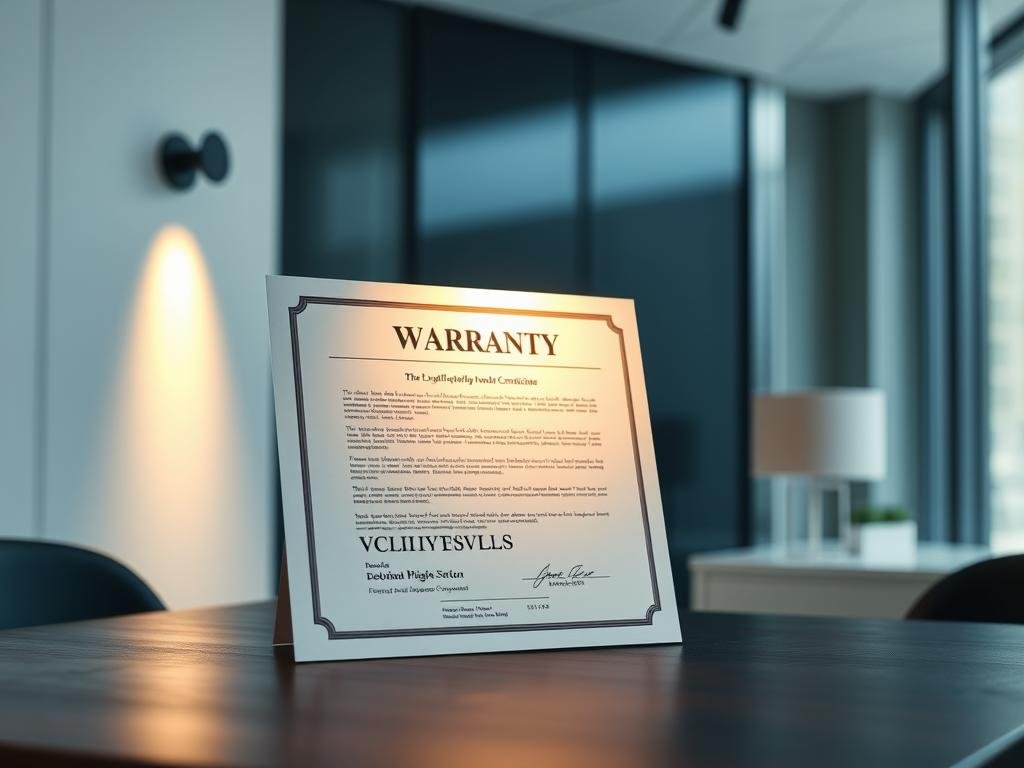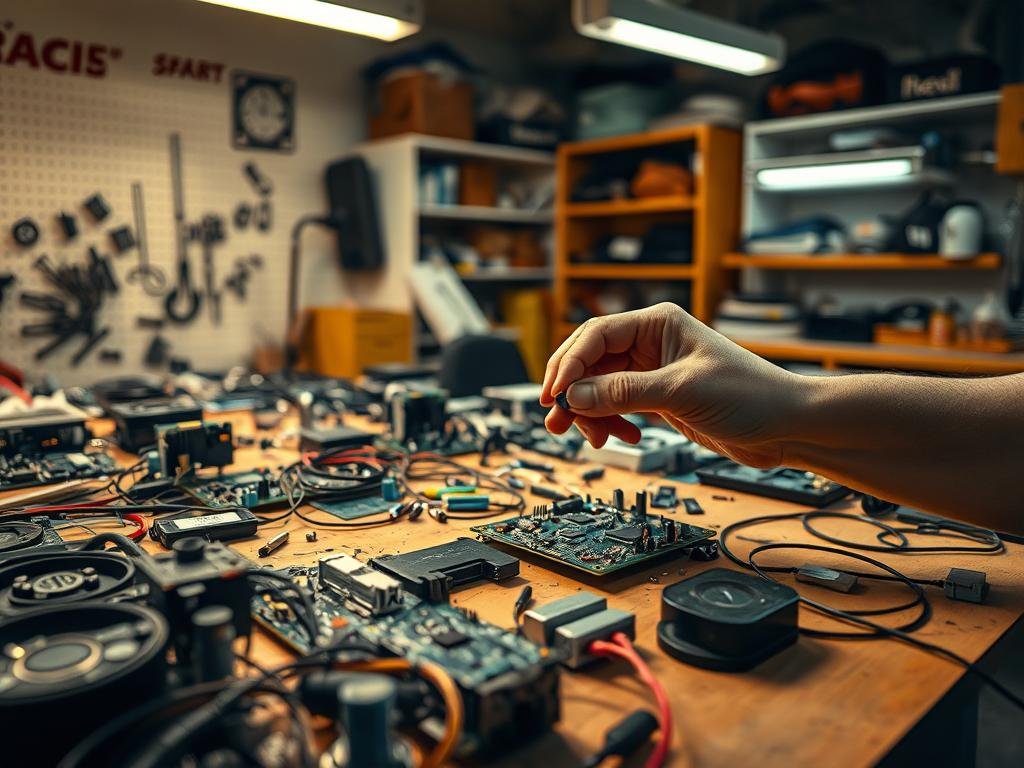Did you know millions of electronic devices are thrown away each year? This happens often before people try to fix them. Knowing about warranty coverage can help you decide if to fix or replace your gadgets.
According to Innovation, Science and Economic Development Canada, a warranty is a promise from the maker. It says they will fix or replace your device within a certain time. This shows how key it is to understand your warranty.
Knowing what your warranty covers can save you money. It’s important to check your warranty details. This way, you can make smart choices about your electronics.
Key Takeaways
- Understand your device’s warranty terms to make informed repair or replacement decisions.
- Review warranty coverage to avoid unnecessary expenses.
- Manufacturer’s warranties typically cover workmanship or defects.
- Implied warranties may also apply to electronics sold “as is.”
- Saving stored information is key before sending devices for warranty repairs.
Understanding Your Warranty Coverage
Dealing with electronics warranties can seem tough. But it’s key to know you’re protected if something breaks. Your warranty is a promise from the maker or warranty provider to fix or replace your device if it doesn’t meet standards.
Types of Warranties
There are mainly two kinds of warranties: the manufacturer’s and the extended warranty. The manufacturer’s warranty comes with the device’s cost and covers repairs and replacements for a year or two. An extended warranty is an extra plan you can buy to extend the warranty period.
What’s Typically Covered?
Warranties usually cover defects in materials and workmanship. If your device fails because of a manufacturing flaw, the warranty will help with repairs or a new one. It’s important to check your warranty to know what counts as a defect.
Common Exclusions
While warranties cover many issues, there are things they don’t. Damage from accidents, misuse, or neglect is often not covered. Also, warranties might not cover problems from software or outside factors like power surges. Knowing these exclusions helps you understand what your warranty covers.
Understanding your warranty well helps you deal with any defective electronics. This way, you can get the most from the warranty offered by the manufacturer or warranty provider.
Signs Your Electronics Need Repair
Knowing when your electronics need repair can save you time and money. It’s important to spot the signs that your device is not working right.
Performance Issues
Performance problems are a clear sign that something’s wrong. If your device freezes, runs slow, or has glitches, it might need fixing. For example, if your phone’s screen doesn’t work right, you might need to fix the ghost touch issue.
Regular updates can help sometimes. But if problems keep coming back, you might need a pro to fix it.
Physical Damage
Physical damage is another warning sign. Cracks, dents, or other damage can hurt your device’s function. Even if it looks okay, it can cause bigger problems later.
A cracked screen, for instance, can lead to display issues or make your device more prone to damage.
Unusual Noises or Smells
Strange noises or smells from your electronics are big red flags. Grinding, buzzing, or burning smells mean something’s wrong inside. These signs often point to serious problems that need quick fixing to avoid more damage or safety risks.
| Signs | Description | Possible Action |
|---|---|---|
| Performance Issues | Glitches, slow operation, freezing | Software update or professional repair |
| Physical Damage | Cracks, dents, physical trauma | Repair or replace damaged parts |
| Unusual Noises or Smells | Grinding noises, buzzing sounds, burning smells | Professional repair or replacement |
Spotting these signs early and acting fast can make your electronics last longer. Also, knowing your warranty options and when to file a warranty claim can save you money on repairs.
When to Consider a Repair
Knowing when to fix your electronics can save you money and make your devices last longer. You need to think about the repair cost, if parts are available, and how long the device will last.
Cost-Effectiveness of Repairs
First, check if the repair is worth it. uBreakiFix by Asurion says if the repair is over half the device’s price, it might be better to get a new one. Compare the repair cost to buying a new device.
For example, fixing a broken smartphone screen might cost $200. If the phone was $400, it’s a good deal. But if it costs $300, it might be cheaper to buy a new phone.
| Device | Repair Cost | Original Price | Cost-Effectiveness |
|---|---|---|---|
| Smartphone | $200 | $400 | Yes |
| Laptop | $500 | $800 | Maybe |
| Tablet | $150 | $300 | Yes |
Availability of Spare Parts
It’s important to know if parts are easy to find. For common devices, parts are usually available. But for older or rare models, finding parts can be hard and expensive.
Quote:
“The availability of spare parts can significantly influence the decision to repair or replace a device. If parts are scarce or expensive, replacement might be the more practical option.”
Lifespan of the Device
Think about how long your device will last and its current state. If it’s new and the problem is small, fixing it can help it last longer. But if it’s almost time to replace it, it might be better to just get a new one.

By looking at these points, you can decide if fixing or replacing your electronics is best. This way, you’ll get the most value for your money and consider your warranty.
Assessing Repair Costs
Figuring out repair costs is key when deciding to fix or replace electronics. This involves several important steps to make a smart choice.
Getting Estimates from Repair Shops
First, get quotes from different repair shops. This helps you compare prices and services to find the best deal. Make sure to give detailed info about your device’s problem for accurate quotes.
Tip: Always ask about extra costs or fees. Some shops might charge for diagnostics or other services.
DIY Repair vs. Professional Help
Then, think about DIY repair versus professional help. DIY can save money but needs technical skills and tools. Professional repairs are pricier but often come with a warranty.
- DIY is good for simple fixes, like screen or battery replacements.
- Professional help is best for complex issues or if you’re unsure.
Warranty Implications on Repairs
It’s also important to understand your warranty’s impact on repairs. If your device is under warranty, some repairs might be free. But, check your warranty to see what’s covered.
Review your warranty or contact the manufacturer to clear up any questions about coverage.
By carefully looking at repair costs, weighing your options, and knowing your warranty, you can decide wisely whether to repair or replace your electronics.
When Replacement is the Smart Choice
Deciding whether to fix or replace your electronics involves several factors. These include new technology, repair costs, and your device’s condition. Each plays a role in your decision.

New Technology and Features
New technology and features can make your electronics better. For example, newer smartphones have better batteries, cameras, and processors. uBreakiFix by Asurion suggests replacing old or damaged devices for cost savings.
Some key benefits of new technology include:
- Enhanced performance and efficiency
- Improved security features
- Better compatibility with the latest software and accessories
Significant Repair Costs
Repair costs are another important factor. If fixing your device costs as much as a new one, it’s smarter to replace it. Check your warranty information to see if repairs are covered, which can save you money.
“If the repair cost is more than half the price of a new device, it’s generally time to consider replacing it.”
Overall Device Condition
The condition of your device is also key. If it’s old, has many problems, or isn’t supported by the maker, it’s time for a new one. See if your device is under warranty claim or if the maker offers support.
Consider the following when assessing your device’s condition:
- The age of the device and its original purchase date
- The frequency and severity of any issues you’ve experienced
- Whether the device is yet receiving software updates
Recycling and Disposing of Old Electronics
Getting rid of old electronics is more than just throwing them away. It’s about caring for our planet. As technology gets better, we must handle electronic waste wisely. Recycling old tech can greatly cut down on pollution, as uBreakiFix by Asurion points out.
Responsible Disposal Options
There are many ways to dispose of old electronics the right way. Recycling is a top choice. Many companies and stores have recycling programs for old devices. For example, you can find recycling centers in Vancouver that make it easy to recycle your gadgets.

Donating or Selling Electronics
If your gadgets work well, think about donating or selling them. Giving to charities can help others and keep devices in use longer. Or, you can sell them online or at second-hand stores. This way, you help reduce waste and might even make some cash.
Environmental Considerations
Throwing away electronics the wrong way can harm our environment. They often contain harmful materials like lead and mercury. These can pollute our soil and water. Recycling or donating helps avoid these problems.
When it’s time to get rid of your old electronics, choose wisely. Recycling, donating, or selling them all help the planet. You’re taking a step towards a greener future with every device you recycle or give away.
Understanding Consumer Rights
Knowing your rights as a consumer can make dealing with warranties easier. It’s key to understand your rights when buying electronics. This knowledge helps you make smart choices and avoid problems.
Lemon Laws in Your State
Lemon laws protect you from bad products. They cover cars and sometimes electronics too. To know your rights, you should:
- Check your state’s lemon laws
- Learn what makes a product a “lemon”
- Find out how to file a claim
Some states make manufacturers fix or replace bad products quickly. If your electronics aren’t working right, look up your state’s lemon laws. This will help you know what to do next.
Communication with Manufacturers
Talking well with manufacturers is important when you have warranty problems. To make things go smoothly:
- Keep a record of all your talks, including who you spoke with and when.
- Tell the manufacturer about your problem and what you’ve tried so far.
- Ask about their warranty rules and how they work.
Being clear and open can often fix problems quickly.
Consumer Protection Agencies
Consumer protection agencies help keep your rights safe. They guide you through warranty issues and help solve disputes.
Some important agencies include:
| Agency | Description |
|---|---|
| Federal Trade Commission (FTC) | Protects consumers from unfair business practices |
| Consumer Product Safety Commission (CPSC) | Ensures the safety of consumer products |
| Your state’s Attorney General’s office | Handles consumer complaints and provides guidance on state-specific laws |
By knowing your rights and where to get help, you can handle warranty issues with confidence. This protects your interests as a consumer.

Tips for Extending the Life of Your Electronics
By adopting a few simple habits, you can extend your electronic devices’ life. Proper maintenance, software updates, and safe usage are key. These practices help keep your devices running smoothly.
Proper Maintenance Practices
Regular maintenance is vital for your electronics’ longevity. Keep devices clean and free from dust. Also, ensure vents and fans are not blocked.
uBreakiFix by Asurion suggests restarting devices often. This clears out temporary issues.
- Use a soft cloth to wipe down screens and exteriors.
- Avoid eating or drinking near electronics to prevent spills.
- For more complex maintenance, consider consulting a professional.
Software Updates and Upgrades
Keeping your device’s software up to date is key for performance and security. Updates fix bugs and vulnerabilities. For more info, visit Consumer Protection.
- Regularly check for software updates in your device settings.
- Enable automatic updates where possible.
- Consider upgrading your device if it’s no longer supported with updates.
Safe Usage Recommendations
Safe usage prevents damage and ensures your safety. Avoid overcharging batteries. Use authorized chargers and accessories to prevent damage.
- Use surge protectors to safeguard against power surges.
- Avoid extreme temperatures and humid environments.
- Handle devices with care to prevent physical damage.
By following these tips, you can extend your electronics’ life. Regular maintenance, software updates, and safe usage are essential. These practices make a big difference.
Making Informed Decisions
When deciding whether to repair or replace your electronics, it’s key to make a smart choice. You need to think about what you need, your budget, and get advice from experts. Looking at your warranty can also help you understand your options better.
Assessing Your Requirements
First, think about what you need from your device. If it meets your needs, fixing it might save you money. This is true if you have warranty coverage.
Budget Considerations
Next, weigh the cost of fixing it versus buying a new one. Check if the repair fits within your warranty. Then, compare this to the price of a new device.
Expert Advice
Getting advice from professionals can also help. Talk to a repair service for an estimate and advice. They can explain your warranty and help you decide.
FAQ
What is the difference between a manufacturer’s warranty and an extended warranty?
A manufacturer’s warranty is a basic warranty from the maker. It covers repairs and replacements for parts and labor for a set time. An extended warranty is an extra warranty that goes beyond the standard one.
What is typically covered under a warranty?
Warranty coverage usually includes fixing or replacing faulty parts. It also covers labor costs. Sometimes, it includes other costs related to the repair or replacement.
How do I know if my electronics are stil under warranty?
To find out if your electronics are under warranty, contact the maker or check the warranty info with your device. You can also look at your warranty papers or the maker’s website for details.
What are some common signs that my electronics need repair?
Signs your electronics need fixing include performance issues like glitches or slow downs. Physical damage, like cracks or dents, is another sign. Unusual noises or smells can also mean there’s a problem inside.
How do I assess the cost-effectiveness of repairing my electronics?
To figure out if fixing your electronics is worth it, look at the repair cost. Consider the device’s age and condition, and the cost of a new one. Get repair quotes and think about DIY versus professional repair.
When is it more cost-effective to replace my electronics instead of repairing them?
Replacing your electronics is better when the repair cost is high. If the device is old or in bad shape, it’s also a good time to replace it. Think about the benefits of new tech and features too.
How can I responsibly dispose of my old electronics?
You can recycle, donate, or sell your old electronics responsibly. Choose an eco-friendly way to dispose of them, considering the environment.
What are my consumer rights when dealing with warranties and electronics?
Your rights include protection under lemon laws and the right to talk to manufacturers. You also have access to consumer protection agencies. Know your rights and stand up for them when dealing with warranties and electronics.
How can I extend the life of my electronics?
To make your electronics last longer, maintain them properly. Keep software updated and use your devices safely. Regular care can extend their life.
What factors should I consider when deciding whether to repair or replace my electronics?
When choosing to fix or replace your electronics, think about your needs and budget. Consider the device’s condition too. Trust experts and weigh the pros and cons to make a good choice.
How do I know if I have warranty coverage for my electronics repair?
To see if you have warranty coverage, check your warranty papers or contact the warranty provider. Understand what your warranty covers and what it doesn’t.
What is the role of a warranty provider in electronics repair?
A warranty provider handles warranty claims and offers repair or replacement services. Know their role and communicate with them to solve warranty issues.
